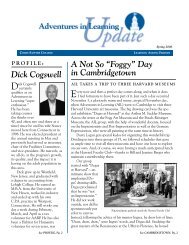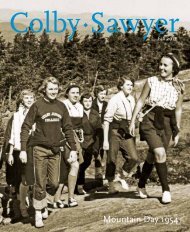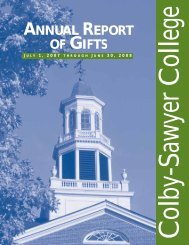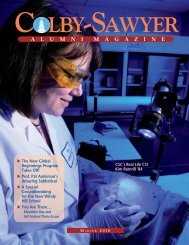A L U M N I M A G A Z I N E - Colby-Sawyer College
A L U M N I M A G A Z I N E - Colby-Sawyer College
A L U M N I M A G A Z I N E - Colby-Sawyer College
Create successful ePaper yourself
Turn your PDF publications into a flip-book with our unique Google optimized e-Paper software.
Much of the physicality in Neary’s classroom comes from<br />
her experience of teaching an experimental all-boys class based<br />
on Dr. Leonard Sax’s research into how boys learn—he says<br />
you can’t teach boys the same way you teach girls.<br />
“In a mixed class you have to gear some lessons to how boys<br />
learn, and when they learn and what they’re open to,” explains<br />
Neary. “If you only ask ‘How do you feel about that poem?’<br />
they’re not going to react because they don’t want to talk about<br />
their feelings. But if you have a swordfight to represent that<br />
poem, they might get hooked.”<br />
In 2008, Neary knew when boys dropped out—after ninth<br />
grade—and considered what she had seen in her lower-level<br />
reading class for freshmen, which students entered with reading<br />
levels as low as second and third grade.<br />
“They drop out and they’re failures at 14, because they can’t<br />
read and write,” says Neary. “The social studies teacher says,<br />
‘Read this chapter on the Great Wall of China and the silk trade’<br />
and they’re like, ‘Read what?’ None of the words make sense.<br />
So why would you want to come to school every day and be a<br />
failure? And be six feet tall and look like you’re a grown man?”<br />
26 COLBY-SAWYER ALUMNI MAGAZINE<br />
Neary requested a group of incoming ninth grade boys and<br />
spent the summer learning how to teach them. She discovered,<br />
for example, that boys don’t sit still. When school started,<br />
she gave one boy a clipboard on which to take notes while<br />
he paced. She put a Rubik’s Cube in the hands of an excellent<br />
listener who simply needed something to fidget with. By<br />
March 2009, these boys had written poems of hope, apology,<br />
grief, despair and triumph that were published in the school’s<br />
magazine, Magpie. Twenty-three of the 24 students passed and<br />
increased their reading levels by one or more grade levels.<br />
Though a success, the school moved on to other projects<br />
and the all-boys class experiment faded away. The lessons<br />
Neary learned didn’t.<br />
“That class totally changed the way I teach,” she says.<br />
“And because that was a relatively small class, it taught me—<br />
as <strong>Colby</strong>-<strong>Sawyer</strong> taught me—the importance of individual<br />
instruction. It’s hard to do with a lot of children in your classroom,<br />
but the more time I can spend with each one, the better.<br />
It has a lot to do with noticing what each child can do.”<br />
Senior Veronica Vergara says Neary’s attention and concern









